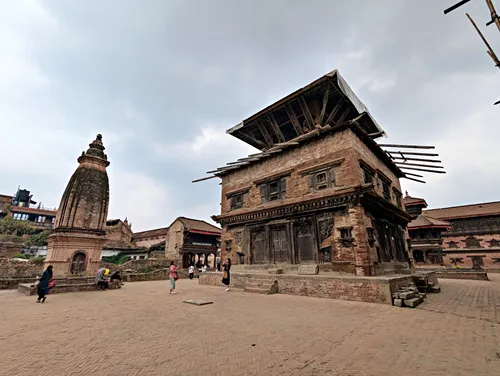Yaksheshwar Mahadev & Guhyeshwari: Your Guide to Bhaktapur's Sacred Sites - Nepal Purple Travel Guide
(map, reviews)
This is Premium Content! To access it, please download our
Backpack and Snorkel Purple Travel GuideYaksheshwar Mahadev Temple is often called Pashupatinath Temple of Bhaktapur. It is one of the oldest temples in Bhaktapur. Unfortunately, the 2015 earthquake collapsed the lower section of its pagoda-style roof. At the time of writing, the lower roof is still missing.

Here at Backpack and Snorkel Travel Guides, we typically promote self-guided walking tours.
But we realize that not everybody likes to walk by themselves in a foreign city. So, just in case that you rather go with ab guide: NO PROBLEM! Please see the Viator tours below.
free GuruWalk tours
paid Viator tours
Origin of the Name Yaksheshwar Mahadev Temple
The name ‘Yaksheshwar’ is derived from the combination of ‘Yaksha’, a nature spirit in Hindu mythology, and ‘Ishwar’, meaning God. According to local lore, the temple was built to honor Lord Shiva as Yaksheshwar, the protector of nature and a deity who safeguards both the earthly and spiritual realms.
Origin of the Name Pashupatinath Temple of Bhaktapur
‘Pashupatinath’ is a Sanskrit term composed of three parts:
'Pashu' – means ‘living beings’ or ‘animals’.
'Pati' – means ‘lord’ or ‘protector’.
'Nath' – means ‘god’ or ‘master’.
So, Pashupatinath translates to ‘Lord of All Living Beings’, one of the most revered forms of Lord Shiva.
The name ‘Pashupatinath Temple of Bhaktapur’ means that this temple is a localized or replica version of the main Pashupatinath Temple in Kathmandu, which is one of the holiest Hindu shrines in the world.
Historical and Spiritual Significance of Yaksheshwar Mahadev Temple
The Yaksheshwar Mahadev Temple was consecrated by Karpura Devi in 1484 and was dedicated to her deceased husband, King Yaksha Malla.
At the heart of the temple is a Shiva Lingam, a symbol of Shiva’s divine energy and creation. Temples to Lord Shiva, especially those housing a Shiva Lingam, are believed to radiate intense spiritual energy, some even say it can be fierce or overwhelming.
To address this, Chyasalin Mandap was constructed as a physical and spiritual barrier between the Royal Palace and Yaksheshwar Mahadev Temple. This ensured that:
The sanctity of the temple was respected by ensuring distance. Living too close could be seen as disrespectful or polluting the sanctity of the temple.
A transitional space between the divine (temple) and the royal (palace) was created. Even though the Malla kings were seen as divine rulers, they still recognized a clear boundary between the realm of the gods and their own royal authority. By not living next to the temple, they honored that distinction and positioned themselves as humble devotees rather than equals to the gods.
The temple is primarily used for religious worship, especially by devotees of Lord Shiva. It holds significance during major Hindu festivals like Maha Shivaratri, where crowds gather to offer prayers and participate in ceremonies.
Architectural Features of Yaksheshwar Mahadev Temple
The temple is notable for its finely carved wooden struts (all struts have different images) and intricately designed roofs, typical of Newar architecture. Unfortunately, at the time of writing the lower part of the roof is missing. The temple’s ornate structure and beautiful wood carvings containing detailed erotic wooden carvings can still be marveled at, however.
Guhyeshwari of Bhaktapur
Just south of the Yaksheshwar Mahadev Temple stands a small shrine dedicated to the goddess Annapurna, which is also referred to as the Guhyeshwari of Bhaktapur.
Origin of the Name Annapurna
Annapurna is the goddess of food, nourishment, and abundance - her name is derived from Sanskrit and means ‘filled with food’ with Anna = food, and Purna = full.
Origin of the Name Guhyeshwari of Bhaktapur
The term ‘Guhyeshwari’ refers to the Guhyeshwari Temple in Kathmandu, a sacred Shakti Peeth (a highly revered pilgrimage site in Shaktism, a major denomination of Hinduism focused on the worship of the Goddess Shakti, the divine feminine power) and an important temple dedicated to Goddess Sati/Parvati in her fierce and secret (guhya) form.
Goddess Sati and Goddess Parvati are intimately connected, with Parvati being the reincarnation of Sati.
Spiritual Significance of Guhyeshwari of Bhaktapur
Guhyeshwari of Bhaktapur is deeply connected to tantric traditions and considered the feminine counterpart to the Pashupatinath Temple.
The presence of both, Shiva (as Pashupati/Yaksheshwar) and Parvati (as Annapurna/Guhyeshwari) within the same area reflects a cosmic balance between divine masculine and feminine, destruction and nourishment, asceticism and abundance — a core concept in Hindu cosmology.
Back to your self-guided tour
Author: Rudy at Backpack and Snorkel
Bio: Owner of Backpack and Snorkel Travel Guides. We create in-depth guides to help you plan unforgettable vacations around the world.
Other popular Purple Travel Guides you may be interested in:
Like this Backpack and Snorkel Purple Travel Guide? Pin these for later:





